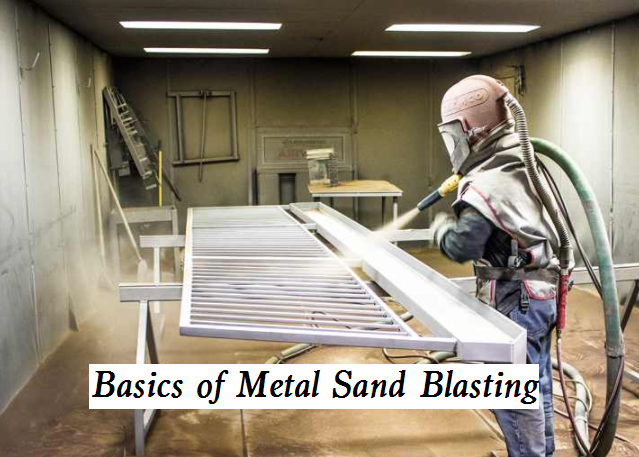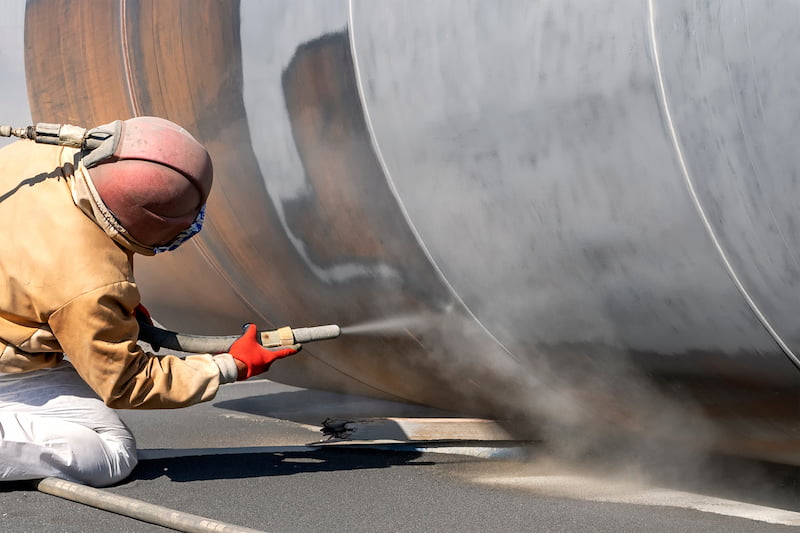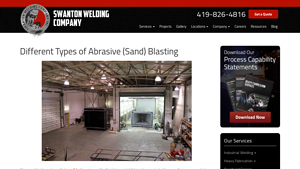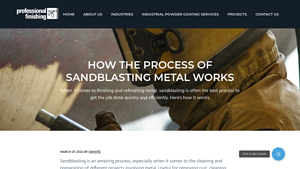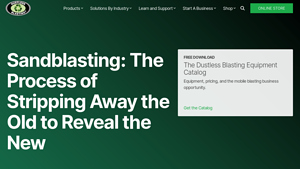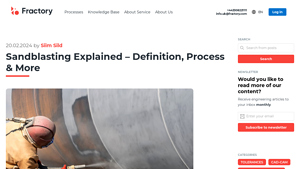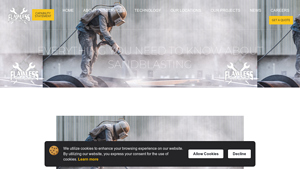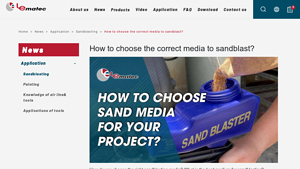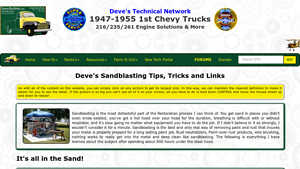Metal Sandblasting Guide: Type, Cost, Top List…
Introduction: Navigating the Global Market for metal sandblasting
In today’s competitive landscape, sourcing effective metal sandblasting solutions can be a daunting challenge for international B2B buyers. With the increasing demand for high-quality surface preparation across various industries, understanding the nuances of sandblasting technologies, materials, and techniques is essential. This guide serves as a comprehensive resource, covering everything from the different types of abrasive blasting media—such as steel grit and glass beads—to their specific applications in sectors like automotive, marine, and construction.
As buyers from Africa, South America, the Middle East, and Europe (including Germany and Vietnam) navigate the complexities of the global market, they face pressing questions about supplier vetting, cost implications, and environmental considerations. This guide equips decision-makers with actionable insights to enhance their purchasing strategies. By offering clarity on the benefits and limitations of various sandblasting methods, it empowers businesses to make informed choices that align with their operational needs and sustainability goals.
Understanding these critical factors not only streamlines procurement but also ensures optimal outcomes in surface preparation and finishing processes. With this guide, international B2B buyers can confidently navigate the metal sandblasting market, ensuring they select the right solutions to meet their specific requirements while fostering long-term supplier relationships.
Understanding metal sandblasting Types and Variations
| Type Name | Key Distinguishing Features | Primary B2B Applications | Brief Pros & Cons for Buyers |
|---|---|---|---|
| Silica Sand Blasting | Traditional method using silica sand as the abrasive. | General metal cleaning and preparation. | Pros: Cost-effective; Cons: Health hazards from silica dust. |
| Soda Blasting | Uses sodium bicarbonate; gentle on softer metals. | Automotive restoration, delicate surfaces. | Pros: Non-damaging; Cons: Less effective on heavy rust. |
| Steel Grit Blasting | Employs steel grit for aggressive cleaning. | Heavy machinery, automotive, aerospace. | Pros: Fast and effective; Cons: Can leave a rough finish. |
| Glass Bead Blasting | Utilizes small glass beads for a smooth finish. | Paint preparation, decorative finishes. | Pros: Eco-friendly; Cons: Less effective on heavy corrosion. |
| Bristle Blasting | Uses rotating steel bristles for tough surface cleaning. | Industrial machinery, heavy corrosion. | Pros: Effective on tough stains; Cons: Limited to harsh surfaces. |
What Are the Characteristics of Silica Sand Blasting?
Silica sand blasting is the traditional approach to abrasive blasting, utilizing ordinary sand as the primary medium. This method is effective for general cleaning and preparing metal surfaces, removing contaminants like rust and mill scale. However, buyers must consider the health risks associated with silica dust exposure, which has led to increased regulatory scrutiny in many regions. While cost-effective, companies should invest in proper safety equipment and ventilation systems to mitigate these risks.
How Does Soda Blasting Differ from Other Methods?
Soda blasting employs sodium bicarbonate as its abrasive, making it a gentler option suitable for softer metals and delicate surfaces. This method is particularly popular in automotive restoration, where it effectively cleans surfaces without causing damage. Buyers should note that while soda blasting is less abrasive, it may not be as effective on heavily rusted surfaces, making it essential to evaluate the condition of the metal before choosing this method.
What Makes Steel Grit Blasting a Preferred Choice for Heavy Industries?
Steel grit blasting is known for its aggressive cleaning capabilities, making it ideal for heavy machinery, automotive, and aerospace applications. This method quickly removes rust and prepares surfaces for painting, ensuring a smooth finish. While it is highly effective, buyers should be aware that it can leave a rough surface texture, which may require additional finishing processes. The recyclability of steel grit also presents an economical advantage for high-volume operations.
Why Choose Glass Bead Blasting for Paint Preparation?
Glass bead blasting is favored for its ability to produce a smooth, satin finish on metal surfaces, making it an excellent choice for paint preparation and decorative applications. This method is eco-friendly, as it utilizes silica-free beads that can be reused. However, buyers should consider its limitations; while effective for cleaning, it may not remove heavy rust or corrosion as efficiently as other methods. This makes it crucial to assess the specific needs of the project before selection.
When Is Bristle Blasting the Best Option?
Bristle blasting utilizes rotating steel bristles to effectively clean tough surfaces and remove heavy corrosion. This method is particularly beneficial for industrial machinery that may have accumulated significant wear and tear. While it excels at deep cleaning, its application is limited to harsher surfaces, making it unsuitable for delicate materials. Buyers should weigh the need for aggressive cleaning against the potential for surface damage when considering this option.
Key Industrial Applications of metal sandblasting
| Industry/Sector | Specific Application of metal sandblasting | Value/Benefit for the Business | Key Sourcing Considerations for this Application |
|---|---|---|---|
| Automotive Manufacturing | Rust and paint removal from vehicle parts | Enhances surface quality for better paint adhesion | Availability of eco-friendly abrasives and equipment |
| Aerospace | Surface preparation of aircraft components | Reduces weight and improves performance | Compliance with international safety and environmental standards |
| Heavy Machinery | Cleaning and refurbishing of machinery components | Extends equipment lifespan and operational efficiency | Access to specialized sandblasting equipment and skilled operators |
| Construction | Surface treatment of steel beams and structures | Ensures structural integrity and aesthetic appeal | Ability to handle large-scale projects and logistics |
| Marine Industry | Cleaning and maintenance of ships and offshore rigs | Prevents corrosion and prolongs asset life | Availability of mobile blasting units for remote locations |
How is Metal Sandblasting Used in Automotive Manufacturing?
In the automotive sector, metal sandblasting is primarily used for rust and paint removal from vehicle parts. This process prepares surfaces for repainting, ensuring a clean and smooth finish that enhances adhesion. By effectively removing contaminants like rust and old paint, manufacturers can significantly improve the durability and aesthetic appeal of their vehicles. B2B buyers should consider sourcing eco-friendly abrasives to align with sustainable practices and ensure compliance with local regulations, particularly in regions like Europe and South America where environmental standards are stringent.
What Role Does Metal Sandblasting Play in Aerospace Applications?
In the aerospace industry, metal sandblasting is crucial for the surface preparation of aircraft components. This application helps in removing contaminants and ensuring a smooth surface finish, which is vital for reducing drag and improving fuel efficiency. Additionally, it plays a role in weight reduction by eliminating unnecessary coatings. International buyers, especially from the Middle East and Europe, should prioritize suppliers who adhere to stringent safety and quality standards, as any deficiencies can lead to significant operational risks.
Why is Metal Sandblasting Important for Heavy Machinery?
Metal sandblasting is extensively used in the heavy machinery sector for cleaning and refurbishing components. This process removes rust, grease, and other contaminants, thereby extending the lifespan of equipment and enhancing operational efficiency. Buyers in Africa and South America should focus on sourcing sandblasting services that offer specialized equipment tailored for heavy-duty applications, as this ensures that machinery can withstand harsh operational environments and minimizes downtime.
How Does Metal Sandblasting Benefit the Construction Sector?
In construction, metal sandblasting is utilized for surface treatment of steel beams and structures. This technique ensures that surfaces are free from contaminants, which is critical for achieving strong adhesion of protective coatings. Furthermore, it enhances the aesthetic appeal of structures. B2B buyers should seek suppliers capable of managing large-scale projects, particularly in remote areas, as logistical considerations can impact project timelines and costs.
What Advantages Does Metal Sandblasting Provide in the Marine Industry?
The marine industry employs metal sandblasting for the cleaning and maintenance of ships and offshore rigs. This process is essential for preventing corrosion, which can significantly affect the longevity and performance of marine assets. Buyers should consider sourcing mobile sandblasting units, especially for offshore applications, as they provide flexibility and efficiency in maintaining vessels in challenging environments. Ensuring that suppliers use environmentally safe materials is also crucial to comply with maritime regulations.
3 Common User Pain Points for ‘metal sandblasting’ & Their Solutions
Scenario 1: Difficulty in Achieving Consistent Surface Quality
The Problem:
Many B2B buyers struggle with achieving a consistent surface finish across their metal components after sandblasting. This inconsistency can arise due to variations in the blasting media, equipment settings, or even operator skill levels. For businesses that require high precision—such as those in the automotive or aerospace industries—this inconsistency can lead to increased rejection rates, additional rework, and ultimately, higher production costs. It can also compromise the integrity of the final product, leading to potential failures in critical applications.
The Solution:
To overcome this challenge, it’s essential to standardize the sandblasting process. Start by selecting the appropriate blasting media for your specific application. For instance, using steel grit or glass beads can provide different finishes and levels of surface roughness, so choose based on the desired outcome. Next, invest in high-quality sandblasting equipment equipped with adjustable settings to control pressure and media flow. Regularly calibrate your machines and ensure that operators are trained on best practices and the specific requirements of the materials they are working with. Implementing a quality control protocol that includes sample testing of the surface finish can help ensure consistency across batches.
Scenario 2: Environmental and Health Concerns with Traditional Sandblasting
The Problem:
B2B buyers are increasingly aware of the environmental and health hazards associated with traditional sandblasting methods, particularly those that use silica sand. The fine dust generated can pose serious respiratory health risks to workers and lead to environmental contamination. As regulations become stricter globally, particularly in regions like Europe and North America, companies face pressure to adopt safer and more sustainable practices. Failure to comply can result in hefty fines and damage to reputation.
The Solution:
Adopting alternative blasting methods is crucial to mitigating these risks. Consider using dustless blasting techniques, which combine water with the abrasive media to significantly reduce airborne dust and health hazards. Additionally, explore non-silica media options such as crushed glass or aluminum oxide, which are less harmful to both health and the environment. Ensure compliance with local regulations by staying informed about the latest safety standards and practices. Investing in proper ventilation systems and personal protective equipment (PPE) for workers can further enhance safety. Regular training sessions on the use of these alternative methods will ensure that all staff are aware of best practices and the importance of maintaining a safe work environment.
Scenario 3: Inefficiencies in Production Due to Equipment Downtime
The Problem:
Equipment downtime is a significant pain point for many businesses engaged in metal sandblasting. Breakdowns or inadequate equipment can lead to delays in production schedules, increased labor costs, and missed delivery deadlines. For international buyers, especially those operating in competitive markets, such inefficiencies can severely impact profitability and customer satisfaction.
The Solution:
To minimize downtime, it is essential to implement a proactive maintenance program for sandblasting equipment. Regularly scheduled maintenance can catch potential issues before they lead to breakdowns. Additionally, consider investing in advanced sandblasting equipment that features automated diagnostics and alerts for maintenance needs. When sourcing equipment, prioritize suppliers that offer comprehensive service agreements and readily available spare parts to ensure quick repairs when needed. Training staff on basic troubleshooting can also empower them to address minor issues swiftly, keeping production running smoothly. Furthermore, consider establishing a contingency plan that includes backup equipment or alternative providers to mitigate the impact of unexpected downtime. By taking these steps, businesses can enhance their operational efficiency and maintain consistent output.
Strategic Material Selection Guide for metal sandblasting
What Are the Key Materials Used in Metal Sandblasting?
When it comes to metal sandblasting, the choice of material plays a crucial role in determining the effectiveness and efficiency of the process. Below, we analyze four common materials used in sandblasting, focusing on their properties, advantages, disadvantages, and considerations for international B2B buyers.
1. Silica Sand
Key Properties: Silica sand is composed primarily of silicon dioxide and is known for its hardness and angularity. It can withstand high pressure and temperatures, making it suitable for various blasting applications.
Pros & Cons: While silica sand is cost-effective and readily available, it poses significant health risks due to silica dust inhalation. Additionally, it can cause surface damage if not used carefully, especially on softer metals.
Impact on Application: Silica sand is effective for removing rust and paint but requires proper safety measures to mitigate health risks. Its use is declining in favor of safer alternatives.
Considerations for International Buyers: Compliance with health and safety regulations is critical, especially in regions where silica exposure is strictly regulated. Buyers should ensure they are aware of local standards, such as ASTM or DIN, regarding silica use.
2. Steel Grit
Key Properties: Steel grit is made from recycled steel and is known for its durability and high cutting power. It can withstand high pressures and is effective for heavy-duty applications.
Pros & Cons: Steel grit provides a smooth finish and is reusable, which makes it cost-effective over time. However, it can be more expensive upfront compared to silica sand and may require more complex handling and storage solutions.
Impact on Application: Ideal for industrial applications, steel grit is particularly suitable for heavy machinery and automotive parts, where a strong abrasive action is necessary.
Considerations for International Buyers: Buyers should be aware of the recycling processes and standards for steel grit in their region, ensuring compliance with environmental regulations and quality standards.
3. Glass Beads
Key Properties: Glass beads are non-toxic, silica-free, and provide a unique matte finish. They are effective in applications requiring a gentle touch, making them suitable for softer metals.
Pros & Cons: Glass beads are environmentally friendly and do not produce harmful dust. However, they may not be as effective for heavy rust removal and can be more expensive than traditional abrasives.
Impact on Application: Glass beads are ideal for paint preparation and finishing applications, particularly in industries like automotive and aerospace, where surface aesthetics are critical.
Considerations for International Buyers: Buyers should check for compliance with environmental standards and preferences for non-toxic materials in their respective markets, particularly in Europe, where sustainability is a significant concern.
4. Baking Soda
Key Properties: Baking soda is a gentle abrasive that is safe for use on delicate surfaces. It is non-toxic and does not produce harmful dust, making it suitable for various applications.
Pros & Cons: While baking soda is effective for cleaning without damaging the substrate, it may not be suitable for heavy-duty applications and can require frequent media replacement due to its lower durability.
Impact on Application: Ideal for cleaning soft metals and delicate surfaces, baking soda is often used in restoration projects where preserving the underlying material is crucial.
Considerations for International Buyers: Buyers should evaluate the availability and cost of baking soda in their region, as well as compliance with local health and safety regulations.
Summary Table of Material Selection for Metal Sandblasting
| Material | Typical Use Case for Metal Sandblasting | Key Advantage | Key Disadvantage/Limitation | Relative Cost (Low/Med/High) |
|---|---|---|---|---|
| Silica Sand | Rust and paint removal | Cost-effective and widely available | Health risks from silica dust | Low |
| Steel Grit | Heavy machinery and automotive parts | Durable and reusable | Higher upfront cost | Med |
| Glass Beads | Paint preparation and finishing | Non-toxic and environmentally friendly | Less effective for heavy rust | High |
| Baking Soda | Delicate surface cleaning | Gentle on surfaces | Not suitable for heavy-duty tasks | Med |
In conclusion, selecting the right abrasive material for metal sandblasting is essential for achieving optimal results while ensuring safety and compliance with local regulations. Understanding the properties, advantages, and limitations of each material allows B2B buyers to make informed decisions that align with their specific needs and regional standards.
In-depth Look: Manufacturing Processes and Quality Assurance for metal sandblasting
What Are the Main Stages in the Manufacturing Process of Metal Sandblasting?
The manufacturing process for metal sandblasting involves several crucial stages that ensure the final product meets quality and performance standards. These stages include material preparation, forming, assembly, and finishing.
How Is Material Prepared for Sandblasting?
Material preparation is the first and most vital step in the sandblasting process. It involves selecting the appropriate metal substrates, which may include steel, aluminum, or other alloys. The surface of these metals must be thoroughly cleaned to remove any contaminants such as oil, grease, rust, or old paint. This can be achieved through various cleaning methods, including chemical solvents or mechanical scrubbing. The selected abrasive media, such as glass beads or steel grit, must also be prepared, ensuring the granules are of consistent size and quality to achieve uniform results during the blasting process.
What Techniques Are Commonly Used in the Sandblasting Forming Stage?
The forming stage primarily involves the use of specialized sandblasting equipment designed to propel abrasive materials at high speeds against the metal surface. Techniques such as pressure blasting or siphon blasting are commonly employed. Pressure blasting uses a pressurized vessel to accelerate the abrasive, while siphon blasting relies on gravity and suction to draw the media into the air stream. The choice of technique often depends on the specific requirements of the project, including the type of metal being treated and the desired surface finish.
How Does the Assembly Process Fit into Metal Sandblasting?
In some cases, the assembly stage may involve integrating sandblasting into a larger manufacturing workflow, particularly in metal fabrication. This could mean sandblasting individual components before they are assembled into a final product, such as automotive parts or machinery. It is essential to maintain the integrity of the components during this stage to prevent any damage that could compromise the overall quality of the final assembly.
What Finishing Techniques Are Used After Sandblasting?
After the sandblasting process, finishing techniques play a critical role in enhancing the aesthetics and performance of the metal surface. Common finishing processes include powder coating, painting, or applying corrosion-resistant treatments. Each technique has its unique benefits; for instance, powder coating provides a durable, weather-resistant finish, while painting allows for greater color variety. The choice of finishing method depends on the intended use of the metal product and any regulatory requirements that may apply.
What Quality Assurance Measures Are Essential for Metal Sandblasting?
Quality assurance (QA) is a fundamental aspect of the metal sandblasting process, ensuring that the final product meets both customer specifications and international standards. Internationally recognized standards such as ISO 9001 provide a framework for quality management systems, focusing on continuous improvement and customer satisfaction.
Which International Standards Should B2B Buyers Consider?
B2B buyers should be particularly aware of relevant international standards that govern the sandblasting industry. ISO 9001 is a general quality management standard that applies across industries, while industry-specific certifications like CE marking for products sold in Europe or API standards for oil and gas applications may also be crucial. These standards help ensure that the products comply with safety and environmental regulations, thus providing an assurance of quality and reliability.
How Are Quality Control Checkpoints Implemented?
Quality control (QC) checkpoints are integral to maintaining high-quality standards throughout the manufacturing process. Key checkpoints include:
- Incoming Quality Control (IQC): Assessing the quality of raw materials and components upon arrival to ensure they meet specified requirements.
- In-Process Quality Control (IPQC): Monitoring the sandblasting process itself, including equipment calibration and media quality, to identify any deviations in real-time.
- Final Quality Control (FQC): Conducting thorough inspections of the finished product to confirm that it meets all specifications and standards before shipment.
What Common Testing Methods Are Used in Quality Assurance?
Various testing methods are employed to ensure the quality of sandblasted surfaces. These can include visual inspections, surface roughness measurements, and adhesion tests for coatings. Non-destructive testing (NDT) techniques, such as ultrasonic testing or magnetic particle inspection, may also be utilized to detect any subsurface defects without damaging the product.
How Can B2B Buyers Verify Supplier Quality Control Practices?
B2B buyers have several avenues to verify the quality control practices of their suppliers. Conducting audits of the supplier’s facilities can provide insights into their processes and adherence to industry standards. Additionally, requesting quality assurance reports and certifications can serve as evidence of compliance with international standards. Engaging third-party inspection services can further validate the supplier’s claims, offering an objective assessment of their quality control measures.
What Are the Nuances of Quality Control for International B2B Buyers?
International B2B buyers, particularly those from diverse regions such as Africa, South America, the Middle East, and Europe, should be cognizant of regional differences in quality standards and regulations. For instance, European buyers might prioritize CE marking compliance, while buyers in the Middle East may look for specific certifications relevant to their local markets. Understanding these nuances is critical to ensuring that products not only meet quality standards but also align with regional regulatory requirements.
Conclusion
In summary, the manufacturing processes and quality assurance measures for metal sandblasting are complex but essential for ensuring high-quality results. By understanding the stages of production, the importance of quality control, and the specific standards applicable to their regions, B2B buyers can make informed decisions and select suppliers that meet their stringent quality requirements. This knowledge is invaluable for establishing long-term partnerships in the competitive landscape of metal sandblasting.
Practical Sourcing Guide: A Step-by-Step Checklist for ‘metal sandblasting’
Introduction
In the competitive landscape of B2B procurement, sourcing metal sandblasting services requires careful consideration to ensure quality, compliance, and efficiency. This checklist provides a structured approach to guide international buyers through the essential steps of sourcing metal sandblasting, enabling you to make informed decisions that align with your project needs.
Step 1: Define Your Technical Specifications
Clearly outlining your technical requirements is the foundation of a successful sourcing process. Identify the type of metal materials you need to sandblast, the desired finish, and any specific contaminants that need removal. This clarity will help you communicate effectively with potential suppliers and ensure they can meet your expectations.
- Key considerations:
- Material type (e.g., steel, aluminum)
- Finish requirements (e.g., smooth, matte)
- Contaminants to be removed (e.g., rust, paint)
Step 2: Identify Suitable Sandblasting Techniques
Understanding the various sandblasting techniques available is crucial for selecting the right process for your project. Different methods, such as glass bead blasting or steel grit blasting, yield different results and may be more suited to specific applications.
- Research the following:
- Abrasive media options (e.g., silica sand, soda, steel grit)
- Application techniques (e.g., wet vs. dry blasting)
- Environmental considerations (e.g., dust control measures)
Step 3: Evaluate Potential Suppliers
Before committing to a supplier, conducting a thorough evaluation is vital. Review company profiles, request case studies, and seek references from previous clients, particularly those in similar industries or regions. This vetting process ensures that the supplier has a proven track record and can deliver on your project requirements.
- What to look for:
- Certifications and industry standards compliance
- Experience with specific materials or applications
- Client testimonials and case studies
Step 4: Request Quotes and Compare Pricing
Once you have a shortlist of suppliers, request detailed quotes that include all costs associated with the sandblasting process. This should encompass labor, materials, and any additional services such as post-blasting inspections or surface treatments.
- Key factors to compare:
- Cost per square meter
- Estimated turnaround time
- Payment terms and conditions
Step 5: Verify Supplier Certifications
Confirming that potential suppliers hold relevant certifications is essential for ensuring compliance with industry standards and safety regulations. This step mitigates risks associated with quality and environmental impact, which are critical in international transactions.
- Important certifications to check:
- ISO certifications (e.g., ISO 9001 for quality management)
- Environmental compliance certifications (e.g., ISO 14001)
- Occupational health and safety certifications (e.g., OHSAS 18001)
Step 6: Assess Equipment and Technology
Understanding the equipment and technology used by your chosen supplier is vital for ensuring the quality and efficiency of the sandblasting process. Suppliers with modern, well-maintained equipment are more likely to deliver consistent results.
- Questions to consider:
- What type of sandblasting equipment is utilized?
- Are they using any innovative technologies or processes?
- How frequently is their equipment serviced or upgraded?
Step 7: Establish Clear Communication and Expectations
Effective communication is key to a successful partnership. Before finalizing your choice, ensure that you have established a clear line of communication with the supplier, including timelines, project milestones, and points of contact.
- Communication strategies to implement:
- Regular progress updates
- Defined roles and responsibilities
- Clear channels for addressing concerns or changes
By following this checklist, B2B buyers can confidently navigate the procurement process for metal sandblasting services, ensuring they select a supplier that meets their technical and operational needs.
Comprehensive Cost and Pricing Analysis for metal sandblasting Sourcing
What Are the Key Cost Components in Metal Sandblasting?
The cost structure for metal sandblasting involves several key components that contribute to the overall pricing of services. Understanding these elements is essential for B2B buyers to make informed purchasing decisions.
-
Materials: The choice of abrasive media significantly impacts costs. Common materials include silica sand, steel grit, and glass beads, each with varying price points. For instance, silica sand is typically less expensive, while glass beads might incur higher costs due to their specific applications and environmental benefits.
-
Labor: Labor costs are another substantial component, influenced by the skill level required for effective sandblasting. Skilled operators command higher wages, but their expertise can ensure better outcomes, reducing the likelihood of rework.
-
Manufacturing Overhead: This includes costs related to equipment maintenance, utilities, and general facility expenses. Efficient operations can mitigate these overheads, but outdated or poorly maintained equipment can lead to increased costs.
-
Tooling: Specific projects may require specialized tools or custom setups, which can add to initial costs. Investing in quality tooling can enhance productivity and result in better finishing.
-
Quality Control (QC): Implementing stringent QC measures ensures that the finished product meets required specifications, but it also adds to the overall cost. However, a strong QC process can prevent costly mistakes down the line.
-
Logistics: Transportation of materials and finished goods can be a significant cost factor, particularly for international shipping. Incoterms and local regulations may also influence these logistics costs.
-
Margin: Suppliers typically apply a margin to cover their risks and ensure profitability. This margin varies based on market competition, supplier reputation, and the complexity of the service provided.
What Price Influencers Should Buyers Consider?
Several factors can influence pricing in the metal sandblasting industry:
-
Volume and Minimum Order Quantity (MOQ): Bulk orders often attract discounts. Buyers should negotiate for lower rates based on larger volumes, which can substantially decrease the per-unit cost.
-
Specifications and Customization: Custom projects that require unique specifications may incur higher costs. Buyers should be clear about their needs to receive accurate quotes.
-
Material Quality and Certifications: Premium materials or those with specific certifications (e.g., environmental compliance) may lead to higher prices. However, investing in quality can yield better results and durability.
-
Supplier Factors: The reputation and reliability of suppliers can affect pricing. Established suppliers may charge more due to their experience and quality assurance, while new entrants may offer competitive rates to gain market share.
-
Incoterms: Understanding shipping terms can help buyers manage costs effectively. Different Incoterms can shift responsibility and risk, impacting the overall price.
How Can Buyers Optimize Costs in Metal Sandblasting?
B2B buyers can adopt several strategies to enhance cost-efficiency in their metal sandblasting projects:
-
Negotiation: Engage suppliers in discussions about pricing, especially for large orders. Building a long-term relationship can also lead to better terms and discounts over time.
-
Total Cost of Ownership (TCO): Look beyond initial costs and consider the TCO, which includes maintenance, potential downtime, and the longevity of the finished product. A higher upfront investment in quality materials may result in lower long-term costs.
-
Understanding Pricing Nuances for International Transactions: For buyers in Africa, South America, the Middle East, and Europe, factors such as currency fluctuations, tariffs, and local market conditions can influence pricing. It’s crucial to conduct thorough market research and consider these variables when sourcing.
-
Requesting Detailed Quotes: Always ask for comprehensive quotes that break down costs. This transparency allows buyers to identify areas for potential savings and negotiate more effectively.
Conclusion
Understanding the cost structure and pricing influencers in metal sandblasting is vital for B2B buyers. By evaluating these components and employing strategic purchasing practices, companies can optimize their sourcing decisions and ensure they receive the best value for their investment. Keep in mind that prices can vary widely based on location, supplier, and specific project requirements, so thorough research and negotiation are essential.
Alternatives Analysis: Comparing metal sandblasting With Other Solutions
Introduction: Understanding Alternatives to Metal Sandblasting
When considering surface preparation methods for metal fabrication, metal sandblasting is often a go-to solution. However, businesses should explore viable alternatives to determine the best fit for their specific needs. This analysis compares metal sandblasting with other technologies, focusing on performance, cost, ease of implementation, maintenance, and best use cases.
Comparison Table
| Comparison Aspect | Metal Sandblasting | Glass Bead Blasting | Soda Blasting |
|---|---|---|---|
| Performance | Effective for heavy rust and paint removal; fast surface preparation | Produces a smooth, matte finish; less aggressive | Gentle on surfaces; effective on softer metals |
| Cost | Moderate initial investment; media can be costly | Higher operational cost due to media replacement | Lower cost; soda media is inexpensive |
| Ease of Implementation | Requires skilled operators; setup can be complex | Easier to operate; less technical skill needed | Simple setup; no special training required |
| Maintenance | Regular maintenance needed for equipment | Lower maintenance; reusable media | Minimal maintenance; equipment is straightforward |
| Best Use Case | Heavy industrial applications, automotive, marine | Precision work, paint preparation, automotive | Delicate cleaning of softer metals and surfaces |
Detailed Breakdown of Alternatives
Glass Bead Blasting
Glass bead blasting utilizes small glass beads propelled at high speeds to clean and finish surfaces. This method is particularly effective for achieving a smooth, matte finish on metals, making it ideal for paint preparation. One of its main advantages is that it is less aggressive than traditional sandblasting, which means there is a lower risk of damaging softer metals. However, the operational costs can be higher due to the need for frequent media replacement, and while it requires less technical skill, operators still need to understand the nuances of the process to achieve optimal results.
Soda Blasting
Soda blasting employs sodium bicarbonate as the abrasive medium, making it a gentler option for surface cleaning. This method is particularly suited for softer metals and delicate surfaces, as it effectively removes contaminants without causing damage. The simplicity of the setup and the low cost of soda media make it an attractive choice for many applications. However, it may not be suitable for heavy rust or paint removal, limiting its use in more industrial contexts. Additionally, while the equipment is easy to maintain, the frequency of cleaning operations may vary based on project requirements.
Conclusion: Choosing the Right Surface Preparation Solution
Selecting the right surface preparation method depends largely on the specific requirements of your project. Metal sandblasting excels in heavy-duty applications, providing quick and effective cleaning for industrial settings. In contrast, glass bead blasting offers precision and a superior finish, while soda blasting is ideal for delicate surfaces. B2B buyers should evaluate their needs, considering factors such as the type of materials involved, the level of surface contamination, and budget constraints, to make an informed decision that aligns with their operational goals.
Essential Technical Properties and Trade Terminology for metal sandblasting
What Are the Critical Technical Properties in Metal Sandblasting?
When engaging in metal sandblasting, understanding the technical properties of materials and processes is crucial for optimizing performance and ensuring project success. Here are some essential specifications:
1. Material Grade
Material grade refers to the classification of the metal being treated. Different grades indicate varying levels of hardness, corrosion resistance, and tensile strength. For B2B buyers, knowing the material grade is vital because it influences the choice of abrasive media and the blasting technique. For instance, softer metals like aluminum require gentler media to avoid damage.
2. Abrasive Size and Type
The size and type of abrasive particles significantly affect the sandblasting outcome. Common abrasives include silica sand, steel grit, and glass beads. Each type offers unique properties; for example, steel grit is effective for heavy rust removal, while glass beads provide a smooth, satin finish. Understanding the appropriate abrasive for specific applications helps buyers select the most efficient option, reducing time and costs.
3. Pressure Settings
The pressure at which the abrasive is propelled during sandblasting is a critical specification. High pressure can remove thick layers of rust quickly but may damage softer metals. Conversely, lower pressure settings are safer for delicate surfaces. Buyers must consider the pressure requirements to ensure optimal results without compromising the integrity of the materials being treated.
4. Surface Roughness
Surface roughness is a measure of the texture of the blasted surface. It is essential for applications requiring paint adhesion or coating. A rougher surface can enhance bonding for paints and coatings, which is particularly important in industries like automotive and aerospace. Buyers need to specify the desired roughness to ensure compatibility with subsequent finishing processes.
5. Environmental Compliance
With increasing regulations on environmental safety, the choice of abrasive media and blasting techniques must comply with local laws. For example, traditional sandblasting using silica sand poses health risks and is becoming less acceptable. Eco-friendly alternatives, such as soda or glass bead blasting, can be a requirement for companies looking to maintain compliance and corporate responsibility.
Which Trade Terms Should B2B Buyers Know in Metal Sandblasting?
Understanding industry jargon is essential for effective communication and negotiation in the metal sandblasting sector. Here are some common terms:
1. OEM (Original Equipment Manufacturer)
OEM refers to a company that produces parts or equipment that may be marketed by another manufacturer. In sandblasting, OEMs provide specialized equipment designed for specific applications. Buyers should consider OEMs for reliable, high-quality machinery tailored to their needs.
2. MOQ (Minimum Order Quantity)
MOQ is the minimum amount of product a supplier is willing to sell. In the context of sandblasting materials or equipment, understanding MOQ helps buyers manage budgets and inventory efficiently. It is crucial for B2B buyers to negotiate MOQs that align with their operational needs without incurring excess costs.
3. RFQ (Request for Quotation)
An RFQ is a formal document requesting price quotes from suppliers for specific goods or services. In sandblasting, an RFQ can help buyers compare costs, delivery times, and terms from multiple vendors, allowing for informed purchasing decisions.
4. Incoterms (International Commercial Terms)
Incoterms are a set of predefined international trade terms that outline the responsibilities of buyers and sellers regarding shipping, insurance, and tariffs. Understanding these terms is essential for B2B transactions to avoid misunderstandings about who bears the costs and risks at different stages of the shipping process.
5. Lead Time
Lead time refers to the time taken from placing an order until the delivery of goods. In sandblasting projects, knowing the lead time for equipment and materials is crucial for planning and scheduling. Buyers must factor in lead times to ensure timely project completion and avoid costly delays.
By grasping these technical properties and trade terms, B2B buyers in the metal sandblasting industry can enhance their purchasing strategies, ensuring they select the most suitable materials and equipment while fostering effective supplier relationships.
Navigating Market Dynamics and Sourcing Trends in the metal sandblasting Sector
What Are the Key Market Drivers Influencing the Metal Sandblasting Sector?
The global metal sandblasting market is shaped by several key drivers, including rapid industrialization, increased demand for surface preparation, and stringent regulations regarding surface treatment processes. As manufacturing and construction activities expand, particularly in emerging markets across Africa and South America, the need for effective surface finishing techniques is becoming paramount. Additionally, advancements in technology—such as automated sandblasting systems and eco-friendly abrasive materials—are transforming sourcing strategies, enabling international buyers to enhance efficiency and reduce operational costs.
Current trends indicate a shift toward more sophisticated blasting techniques, including the use of recyclable and less harmful abrasives. Innovations such as wet blasting systems are gaining traction, as they significantly reduce airborne dust and improve working conditions. For international B2B buyers, understanding these trends is crucial for making informed sourcing decisions. By adopting advanced equipment and sustainable practices, companies can not only comply with environmental regulations but also enhance their competitive edge in the market.
Moreover, the demand for customization in surface treatment solutions is on the rise. Buyers are increasingly seeking suppliers that can provide tailored services, from specific abrasive materials to specialized equipment that meets unique project requirements. This trend emphasizes the importance of building strong supplier relationships to ensure access to the latest technologies and materials.
How Is Sustainability Influencing Sourcing Decisions in the Metal Sandblasting Industry?
Sustainability has become a critical factor in the metal sandblasting sector, influencing both operational practices and sourcing decisions. The environmental impact of traditional sandblasting methods—especially the use of silica sand—has raised concerns over worker health and ecological safety. Consequently, buyers are increasingly prioritizing suppliers who offer environmentally friendly alternatives, such as glass beads, steel grit, and other non-toxic abrasives that minimize dust production and health risks.
Ethical sourcing is also gaining importance, as stakeholders recognize the need for transparent supply chains. Buyers are now looking for suppliers who can demonstrate adherence to sustainability standards and possess certifications such as ISO 14001 or other green credentials. These certifications not only validate a supplier’s commitment to reducing environmental impact but also enhance the buyer’s reputation in their respective markets.
Additionally, the integration of circular economy principles is becoming prevalent. Companies are seeking ways to recycle blasting materials and reduce waste, which not only contributes to sustainability but also provides cost savings. This evolution in sourcing trends reflects a broader commitment to responsible business practices and the growing demand for ethical considerations in procurement processes.
How Has the Metal Sandblasting Process Evolved Over Time?
The history of metal sandblasting dates back to the late 19th century when it was first introduced as a method for cleaning and preparing surfaces. Initially, the technique relied heavily on sand as the primary abrasive material. However, as awareness of the health risks associated with silica exposure grew, the industry began to explore alternative materials and methods. This evolution has led to the development of various blasting techniques, including grit blasting, soda blasting, and the use of eco-friendly abrasives.
Today, the metal sandblasting sector continues to innovate, focusing on automation and efficiency. Advanced machinery and automated systems are now commonplace, allowing for precision in surface treatment and reduced labor costs. Furthermore, the ongoing research into sustainable practices is shaping the future of sandblasting, ensuring that the industry adapts to modern environmental and health standards while meeting the diverse needs of international B2B buyers.
In summary, the metal sandblasting market is experiencing dynamic changes driven by technological advancements, sustainability concerns, and evolving buyer expectations. By staying informed on these trends, international buyers can make strategic sourcing decisions that align with their business goals and contribute to a more sustainable future.
Frequently Asked Questions (FAQs) for B2B Buyers of metal sandblasting
-
How do I choose the right sandblasting media for my project?
Choosing the right sandblasting media depends on the material you are working with and the desired finish. For instance, silica sand is effective for general purposes but can be harmful to health. Glass beads are suitable for softer metals and provide a satin finish, while steel grit is best for heavy-duty applications like rust removal from hard metals. Evaluate your project’s requirements, including surface material, finish quality, and environmental considerations, to select the appropriate media. -
What are the key benefits of sandblasting for metal surface preparation?
Sandblasting offers several advantages for metal surface preparation, including efficient removal of contaminants like rust and paint. It provides a clean, smooth finish essential for optimal adhesion of coatings or paints. Additionally, sandblasting is environmentally friendly as it eliminates the need for harmful chemicals. Its speed and effectiveness can significantly reduce overall project timelines, making it a preferred choice in various industries, including automotive and manufacturing. -
What are the typical lead times for international sandblasting equipment orders?
Lead times for international orders of sandblasting equipment can vary significantly based on the supplier’s location, manufacturing capabilities, and shipping logistics. Generally, expect lead times to range from 4 to 12 weeks. It’s crucial to communicate with suppliers about their production schedules and shipping options. To avoid delays, consider placing orders well in advance and inquire about expedited shipping methods if needed. -
How can I ensure the quality of sandblasting services from suppliers?
To ensure quality in sandblasting services, start by vetting suppliers through reviews and case studies. Ask for certifications that demonstrate adherence to industry standards, such as ISO or similar quality management systems. Additionally, request samples of their previous work or references from past clients. Establishing clear communication about your project requirements and expectations will also help ensure that the supplier meets your quality standards. -
What are the common payment terms when sourcing sandblasting services internationally?
Payment terms for international sandblasting services often vary by supplier and region. Common arrangements include upfront deposits (typically 30-50%) with the balance due upon completion or delivery. Some suppliers may offer letters of credit or escrow services to protect both parties. Always clarify payment methods, currency preferences, and any applicable taxes or duties before finalizing contracts to avoid misunderstandings. -
What is the minimum order quantity (MOQ) for sandblasting services?
Minimum order quantities (MOQs) for sandblasting services can differ widely depending on the supplier and the nature of the project. Some suppliers may have a low MOQ for standard services, while others might require larger orders for custom or specialized work. It’s essential to discuss your project needs with potential suppliers to determine if their MOQ aligns with your requirements, especially for smaller or one-off projects. -
Are there specific regulations I should be aware of when importing sandblasting equipment?
Yes, when importing sandblasting equipment, it’s crucial to familiarize yourself with local regulations and standards. Many countries have specific requirements regarding safety, environmental impact, and equipment certifications. For instance, compliance with CE marking in Europe or OSHA standards in the United States may be necessary. Always consult with local authorities or customs experts to ensure that your import meets all legal requirements. -
What logistics considerations should I keep in mind when sourcing sandblasting services?
When sourcing sandblasting services, logistics play a vital role in project success. Consider the location of your supplier and the potential impact on shipping costs and delivery timelines. Discuss transportation methods, insurance coverage, and customs clearance processes with your supplier. Additionally, account for any potential delays caused by customs inspections or local regulations. Proper planning and communication can help ensure a smooth logistics process for your sandblasting needs.
Important Disclaimer & Terms of Use
⚠️ Important Disclaimer
The information provided in this guide, including content regarding manufacturers, technical specifications, and market analysis, is for informational and educational purposes only. It does not constitute professional procurement advice, financial advice, or legal advice.
While we have made every effort to ensure the accuracy and timeliness of the information, we are not responsible for any errors, omissions, or outdated information. Market conditions, company details, and technical standards are subject to change.
B2B buyers must conduct their own independent and thorough due diligence before making any purchasing decisions. This includes contacting suppliers directly, verifying certifications, requesting samples, and seeking professional consultation. The risk of relying on any information in this guide is borne solely by the reader.
Top 8 Metal Sandblasting Manufacturers & Suppliers List
1. Swanton Weld – Abrasive Blasting Solutions
Domain: swantonweld.com
Registered: 2001 (24 years)
Introduction: Different types of abrasive (sand) blasting include: 1. Silica Sand: Ordinary sand used for removing surface impurities, providing a clean smooth look. 2. Soda: Non-damaging to softer metals, ideal for delicate materials, providing cleansing and smoothing effects. 3. Steel Grit: Used for blasting and scraping, effective on hard metal surfaces, leaves a smooth finish, recyclable. 4. Glass Bead: Exc…
2. Professional Finishing – Sandblasting Solutions
Domain: professionalfinishing.com
Registered: 2002 (23 years)
Introduction: Sandblasting is a process used for cleaning and preparing metal surfaces. It involves a combination of air and sand, although modern sandblasting uses various materials such as baking soda, crushed walnut shells, garnet, steel grit, powdered glass, and glass and plastic beads. The process effectively removes rust, corrosion, and old paint, providing a cleaner and smoother surface for further treat…
3. Dustless Blasting – Blasting Equipment and Accessories
Domain: dustlessblasting.com
Registered: 2011 (14 years)
Introduction: Products include Blast Pots, Compressor-Ready Carts, Mobile Blasting Trailers, and Blasting Accessories. Dustless Blasting supports various industries such as Automotive, Marine, Concrete, Wood, Fleet Vehicles, Fire Restoration, Graffiti, Powder Coating, Line Stripe, Heavy Equipment, and Pools. The equipment is designed for surface preparation, offering faster, cleaner, and safer solutions. Sandbl…
4. Fractory – Sandblasting Equipment Essentials
Domain: fractory.com
Registered: 2000 (25 years)
Introduction: Sandblasting, also known as abrasive blasting, is a method used to remove surface contamination, smoothen rough surfaces, and roughen smooth surfaces. It utilizes compressed air to propel abrasive materials against surfaces. Key components of sandblasting equipment include:
– Compressor (90-100 PSI) for pressurized air supply.
– Sandblaster (18-35 CFM for standard, 50-100 CFM for industrial) to …
5. FSW – Sandblasting Services
Domain: fsw-denver.com
Registered: 2014 (11 years)
Introduction: Sandblasting, also known as abrasive blasting, is a surface preparation process used to clean and smoothen construction materials. It is effective for removing old paint, rust, and contaminants from surfaces. Suitable materials for sandblasting include concrete, wood, cast iron, and bricks. The sandblasting process involves identifying the material, preparing the area, and using appropriate equipm…
6. LEMATEC – Sandblasting Solutions
Domain: lematec-tools.com
Registered: 2017 (8 years)
Introduction: Comprehensive Guide to Choosing the Best Sandblasting Media, LEMATEC Sandblaster: Easily Restore and Renew Your Shovel, LEMATEC AS-118: Dustless Attachment Unleashed, LEMATEC new sandblaster gun with siphon hose and ceramic, AS118-2c Review, LEMATEC Gravity Feed Portable Sandblasting Gun for remove rust,dust,oil and so on, LEMATEC Ergonomic Portable Sandblaster Gun for remove rust,dust,oil and so …
7. Borders and Blasting – Metal Sandblasting Services
Domain: bordersandblasting.com
Registered: 2019 (6 years)
Introduction: Metal sandblasting is an effective process for removing rust and paint from various metals including cast iron, wrought iron, and aluminium. It is ideal for restoring items such as fireplaces, log burners, stoves, gates, stairways, and frameworks. The service utilizes Quill Falcon’s industry-leading dustless wet blasting system, which allows for precise control over pressure and grit flow, making …
8. Deve – Super-Fine Silica Sand
Domain: devestechnet.com
Registered: 2014 (11 years)
Introduction: Deve’s Sandblasting Tips include the use of #1 Super-Fine Silica Sand for abrasive blasting, which is cost-effective at $4.98 for a 70-pound bag. This media is reusable, does not warp metal, and cuts quickly to bare metal. An alternative is StarBlast by Dupont, a non-silica product available for around $8 a bag. For small parts, a blast cabinet is recommended, with TP Tools being a reliable source…
Strategic Sourcing Conclusion and Outlook for metal sandblasting
The evolving landscape of metal sandblasting presents significant opportunities for international B2B buyers. As industries increasingly prioritize efficiency, sustainability, and safety, strategic sourcing becomes paramount. By selecting advanced, eco-friendly blasting technologies such as glass bead or steel grit, businesses can enhance operational effectiveness while minimizing environmental impact.
Investing in high-quality equipment not only ensures superior surface preparation but also reduces long-term operational costs and health risks associated with traditional sandblasting methods. Moreover, understanding the specific applications and materials suited for various blasting techniques allows buyers to tailor solutions that meet their unique project needs.
Looking ahead, the demand for metal sandblasting services is set to grow, driven by sectors like automotive, aerospace, and construction. International buyers, particularly from Africa, South America, the Middle East, and Europe, should seize this moment to establish partnerships with reputable suppliers. By doing so, they can secure a competitive edge in their markets, ensuring high-quality outcomes for their projects. Embrace strategic sourcing today to position your business for success in the future of metal sandblasting.
